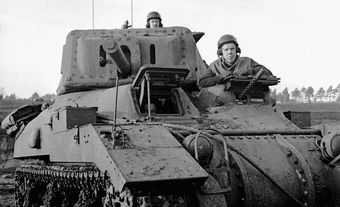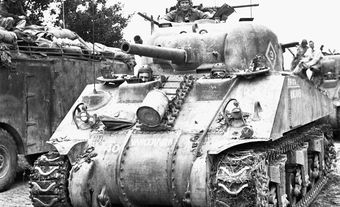The Valentine was a British-designed and -developed infantry tank that first went into production in 1939. By the end of the Second World War, about 8,275 Valentines had been built in Britain and Canada. They saw action in almost every theatre of war from North Africa and Burma to the Eastern Front. Valentines were used in combat by British, New Zealand, Australian, Polish and Soviet armoured units.

Origins and Development
Prior to the Second World War, British tank doctrine divided tanks into three categories: light tanks for reconnaissance, cruiser tanks to act as cavalry to exploit gaps in enemy lines and heavy tanks to support the infantry (also known as infantry tanks).
In February 1938, Vickers submitted a proposal to the British War Office for an infantry tank designed by Sir John Carden, a pioneering armoured vehicle designer. Known as the Valentine, the design was based on Vickers’ Cruiser II Tank but with significantly increased protection.
Production
The Infantry Tank Mark III, Valentine went on to become the most-produced British tank of the war, with 6,855 built in Britain and another 1,420 in Canada. The first Valentines came out in May 1940 and production continued until early 1944. In general terms, the tank weighed around 16 to 17 metric tonnes and had frontal armour up to 65 mm thick. It had a top speed of 24 km/h and a range of 140 to 176 km. An auxiliary fuel tank fitted on some marks added another 120 km to its range.

Models
There were eleven marks of Valentines. The Mark I was powered by a gasoline engine and had a two-man turret mounting a 2-pounder tank gun and a Besa machine gun. Marks II to V saw the introduction of a diesel engine. The Mark III and V upgraded the turret to allow for three crew members including a loader, which allowed the commander to focus on other duties.
Marks VI to VIIA were Canadian-produced Valentines, which replaced the Besa machine gun with a Browning machine gun. The Canadian Valentines also had a cast nose plate rather than a bolted one.
Valentine Marks VIII to X reverted to a two-man turret, but with a more powerful 6-pdr gun. The Mark XI had a 75 mm gun.
Variants
The Valentine had several variants. These included the DD (Duplex Drive) “swimming” tank; the Observation Post variant for artillery spotting; a bridge layer, equipped with a 10-metre-long scissors bridge; and a dozer tank.
Other variants produced in limited numbers included a mine flail and a fascine version to cross large ditches. Among experimental variants, which never saw combat, were the Canal Defence Light, as well as a flame-thrower tank and one with a mortar firing incendiary rounds.
Two British self-propelled guns were mounted on Valentine chassis. The Bishop carried a 25-pdr artillery gun while the Archer had a 17-pdr anti-tank gun.
Canadian Valentines
In 1941, production of Canadian Valentines began at the Canadian Pacific Railway’s Montreal Angus Shops. These vehicles used several North American-built parts and shared some components with the Canadian Ram tank. Around 1,390 Canadian Valentines were sent to Russia, along with 1,300 British ones. Canadian armoured units did not use Valentines in combat, but 30 vehicles were used for training. The Valentine was the first tank produced in Canada.

 Share on Facebook
Share on Facebook Share on X
Share on X Share by Email
Share by Email Share on Google Classroom
Share on Google Classroom


